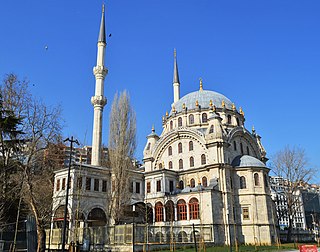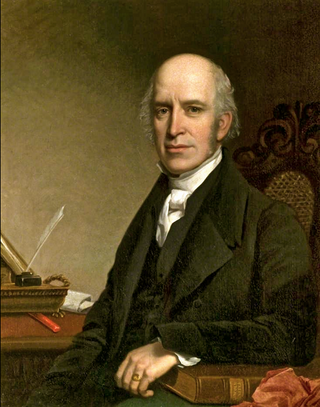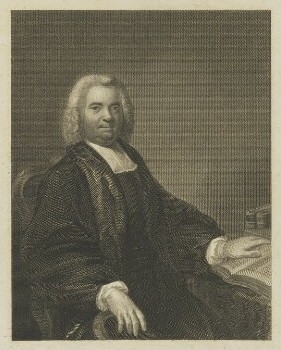Related Research Articles

The Gentleman's Magazine was a monthly magazine founded in London, England, by Edward Cave in January 1731. It ran uninterrupted for almost 200 years, until 1922. It was the first to use the term magazine for a periodical. Samuel Johnson's first regular employment as a writer was with The Gentleman's Magazine.

Richard Cromwell Carpenter was an English architect. He is chiefly remembered as an ecclesiastical and tractarian architect working in the Gothic style.

Ewan Christian (1814–1895) was a British architect. He is most frequently noted for the restorations of Southwell Minster and Carlisle Cathedral, and the design of the National Portrait Gallery. He was Architect to the Ecclesiastical Commissioners from 1851 to 1895. Christian was elected A RIBA in 1840, FRIBA in 1850, RIBA President 1884–1886 and was awarded the Royal Gold Medal in 1887.

Samuel Pegge "the Elder" was an English antiquary and clergyman.

Nusretiye Mosque is an ornate mosque located in Tophane district of Beyoğlu, Istanbul, Turkey. It was built in 1823–1826 by Sultan Mahmut II.
John Gage Rokewode was a historian and antiquarian.

Charles Lyttelton (1714–1768) was an English churchman and antiquary from the Lyttelton family, who served as Bishop of Carlisle from 1762 to 1768 and President of the Society of Antiquaries of London from 1765 to 1768.
Joseph Clarke (1819–1888) was a British Gothic Revival architect who practised in London, England.

George "Sidney" Shepherd was a British draughtsman and watercolourist. At one time, George Shepherd and George Sidney Shepherd were thought to be two different people; it is now believed that they are one and the same person.
John Bathurst Deane was a South African-born English clergyman, schoolmaster, antiquary, and author.

Edward James Willson (1787–1854) was an English architect, antiquary, architectural writer, and mayor of Lincoln in 1851–2.
Thomas Kitson Cromwell (1792–1870) was an English dissenting minister and antiquary.
Thomas Fisher (1772–1836) was an English antiquary.

Mark Noble (1754–1827) was an English clergyman, biographer and antiquary.

The Church of the Holy Trinity is located in Embleton, Northumberland, England. The church, dedicated to the Holy Trinity, is west of the village. Built in the form of a cross, it consists of a two aisle nave, a clerestory, a chancel, a porch, and a chantry chapel. It has a tower with a small vestry, and a gallery. The vicarage house and garden are on a gradual slope on the south side of the churchyard. Traces of stonework show evidence of an earlier church from the 12th century. It is a Grade I listed building.

Alfred John Kempe was an English antiquary.
William Barnard Clarke (1806–1865), sometimes mis-written Bernard, was an English architect, cartographer, archaeological writer and art collector, numismatist and literary translator. He was the founding president of the Architectural Society of London, 1831, and supervised the restoration of the Eleanor Cross at Waltham Cross in 1831–1832. Producing a celebrated series of maps or plans of European and Russian cities, and taking a strong interest in the discoveries at Pompeii, he travelled much in Europe and from the 1840s had his home and collections in the Grand Duchy of Baden. In 1865 he published an English translation of Goethe's Faust. He was an elder brother of the artist Harriet Ludlow Clarke, and a brother-in-law of Henry Bellenden Ker.

Romanesque Revival, Norman Revival or Neo-Norman styles of building in the United Kingdom were inspired by the Romanesque architecture of the 11th and 12th centuries AD.
Charles Clarke was an English numismatist and antiquarian. He served as vicar of Elm from November 1762.

William Drake was an Anglican priest, antiquary and philologist.
References
- 1 2 3 4 Goodwin 1887, p. 417.
- ↑ Goodwin 1887, pp. 471, 418.
- ↑ Architectura Ecclesiastica Londini... on Royal Academy.
- Attribution
 This article incorporates text from a publication now in the public domain : Goodwin, Gordon (1887). "Clarke, Charles (d.1840)". In Stephen, Leslie (ed.). Dictionary of National Biography . Vol. 10. London: Smith, Elder & Co. pp. 417, 418. This source cites:
This article incorporates text from a publication now in the public domain : Goodwin, Gordon (1887). "Clarke, Charles (d.1840)". In Stephen, Leslie (ed.). Dictionary of National Biography . Vol. 10. London: Smith, Elder & Co. pp. 417, 418. This source cites: - Gent. Mag. new ser. xvii. 342;
- Smith's Bibliotheca Cantiana, pp. 153, 210, 211;
- Cruden's Gravesend, p. 459;
- Biographical Dictionary of Living Authors, 1816.